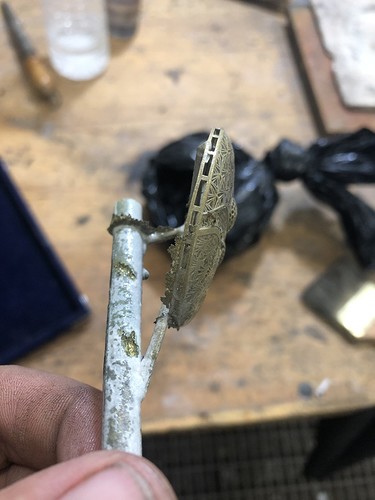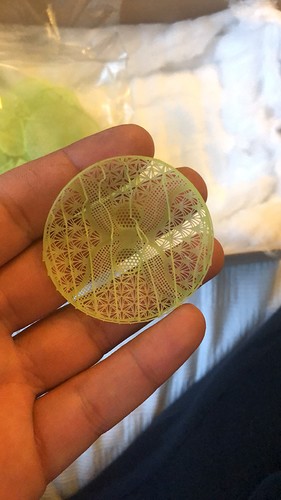Hello my friends, can anyone advise me a suitable exhaust cycle for pouring resin and the temperature of the flask needed for pouring, bearing in mind that the models I have are very accurate, reaching bristles of about 22 microns? The size of the flask is 14cm*25cm
Is this related to your vacuum issues?
Are you casting resins, not wax, not metal?
Are this for the actual cast?
I kind of do not understand what you want to do?
Please give us a more detailed description of your process.
I cast 21 karat gold. I have samples of resin and its exact parts, not ordinary wax. What is the correct cycle of fatigue?
Is this a problem that has started to occur recently?
What has changed in your process?
When did this start to happen?
What kind of resin do you use.
How are the resin models made?
What kind of investment do you use?
There are so many things that may or may not be important to what happens.
That is why I asked you to give some detail to your process.
Additionally many resins are not suited for investments due to heavy expansion during the heating in the burnout cycle.
I tend to suspect investment cracking due to expansion in the burnout cycle.
Some resins can not be burnt out properly.
Others need careful adjustment of the whole cycle.
Regards Per-Ove
Thank you for your response my friend. I always pour regular wax rings on 21 karat gold at a temperature of 730 C for the flask and I did not have any problems, but when I decided to pour resin models with thin parts up to 22 microns I had a problem with the model not filling up and then I raised the flask temperature to 810 C It caused the collapse of investment in me, so I became between two problems, either the lack of fullness or the collapse of investment. I use srs classic, 39% water, 10 hour fatigue cycle, and 9 minutes mixing time
Zakaria
I’m still not entirely sure how you do things.
Language barrier I guess.
But since your problem started when you changed to resin. I would see if another resin would be better.
Are the resin printed?
If so there are wax resins and resins suited for casting.
Resins typically need higher temperature and longer cycles to get proper burnout.
There is also a risk of leaving some residue.
Some blow gently into the flask with air to improve burning and dislodge ash and residue.
One can also use ordinary filament prints.
But they are even harder.
Regards Per-Ove
To make matters simple.
Lets start with:
How do you receive the resin models?
Are they printed?
If so, who prints them, you?
Do you know which resin is used?
Per-Ove
Yes, it is printed by a Turkish company, and the type of Turkish-made resin is green
Very fine strands there.
Have you cast something like that earlier?
Colour has no effect, do you know the name of the resin?
To me it seems to be a hard thing to cast.
It will be essential to get it properly burnt out.
Maybe try to take the investment out a couple of times during burnout and tumble it gently in the air to get out ash and then blow gently into the sprue with a tube. Supplying oxygen to promote burning of the resin.
Just a minute or two so it do not get cold.
That is what they do with pla and filament prints.
What investment do you use?
Have you talked to the supplier regarding this issue?
Per-Ove
Are you from Turkey?
If so why not call them and ask.
What do the SRS classic information say regarding resin and burnout?
Call your supplier maybe?
I do not be difficult, but you are the one holding the key to solve your issues.
You will have the spec sheets to your investment.
You never replied to if you printed in house or not. Just a Turkish company.
If it is not in house, call them, ask for advice or ask them to use a different resin.
Who chose the resin? Is it even suited to the job?
The print look good in the picture, but say nothing about material quality and such.
Way to little information.
Per-Ove
The failure definitely looks like cracking due to resin expansion to me. Personally I would add far more sprues, but I hate having to re-cast things, so I err on the side of caution quite a bit.
What is your casting method? Gravity pour, spin-casting, or vacuum?
We’ve had success casting resin with non-resin specific investments, but they are for stone-in-place casting, and tend to be a bit stronger just due to the additives that they add to protect the stones.
Is your main sprue also printed? The finning at the “top” of it, where the second sprue goes to the middle of the piece is concerning.
If you like SRS investment powders, I would pick up their CADCAST powder and try it. It looks like it’s been developed specifically for resin casting (much like Prestige Optima, and Plasticast from R&R).
I would say you don’t need to raise the flask temp above 730*C, that’s more than enough for castable resins.
Do you have more photos of the failed casting? I’d like to see it from more angles.
But, my initial recommendations would be:
- More sprues, and angle them keeping in mind allowing the best path for the resin and gasses to escape during burnout.
- Switch to an investment designed for resin printing (like SRS CADCAST).
- Possibly add small sprues at the top of the piece, to allow any extra ash to fall in to during casting.
- Also, if you’re vacuum casting, definitely use something like Wax Web (not sure if it’s available in your country though, it’s sold through RioGrande here), I’ve found it makes a huge difference when casting such fine pieces like that.
Good luck! I’m excited to see such a fine detailed piece get cast. Really one of the nice things about 3D printing is the ability to get such fine pieces without hours upon hours of carving wax.
I recommend checking his other posts on the forum in the last days.
He has spread out thin, asking different questions around the same theme all around.
This may enlighten this conundrum i bit more.
Per-Ove
I spoke with the manufacturer Rizin and they told me they don’t have their own burn cycle and that I should try.
Thank you for your advice, my dear brother. I use vacuum casting, but I tried a lot and did not find a good result. I spoke with the manufacturer Resin and talked to them about the issue of fatigue appropriate for their resin, but they replied that they do not have a fatigue schedule and they told me that I should try and not see a good result. Can I tell you what your fatigue schedule is?
I raise the oven temperature to 840 degrees Celsius. I tried to pour at 730 degrees Celsius, but it seems that it does not burn enough considering that I put it at 730 for 4 hours straight.
I’m starting to think that it isn’t all that good of a castable resin. I would recommend a different resin. As far as my burnout schedule, I’ll reference my reply to a different post:
Have you seen the paper James Binnion did for the Santa Fe Symposium on casting resin models?
Judy Hoch


